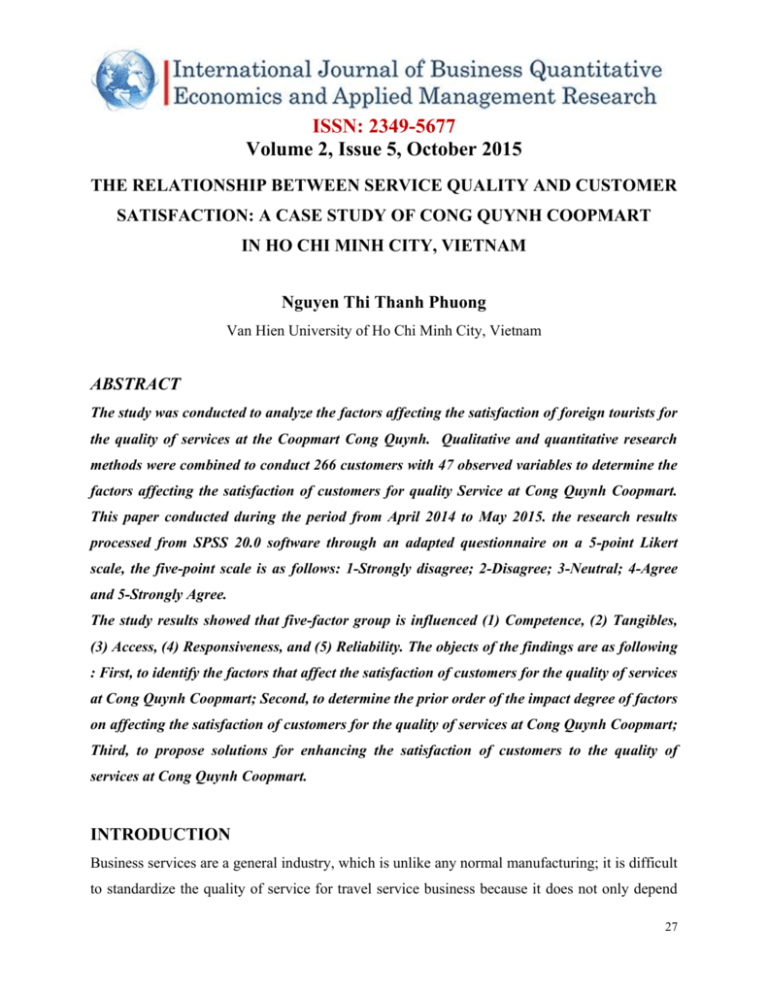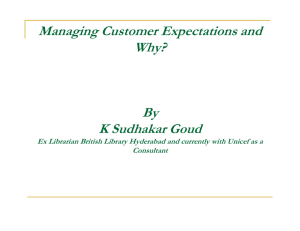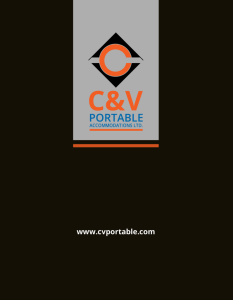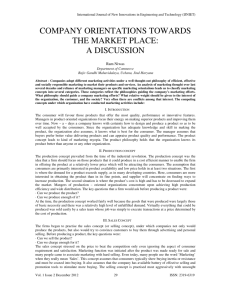ISSN: 2349-5677 Volume 2, Issue 5, October 2015
advertisement

ISSN: 2349-5677 Volume 2, Issue 5, October 2015 THE RELATIONSHIP BETWEEN SERVICE QUALITY AND CUSTOMER SATISFACTION: A CASE STUDY OF CONG QUYNH COOPMART IN HO CHI MINH CITY, VIETNAM Nguyen Thi Thanh Phuong Van Hien University of Ho Chi Minh City, Vietnam ABSTRACT The study was conducted to analyze the factors affecting the satisfaction of foreign tourists for the quality of services at the Coopmart Cong Quynh. Qualitative and quantitative research methods were combined to conduct 266 customers with 47 observed variables to determine the factors affecting the satisfaction of customers for quality Service at Cong Quynh Coopmart. This paper conducted during the period from April 2014 to May 2015. the research results processed from SPSS 20.0 software through an adapted questionnaire on a 5-point Likert scale, the five-point scale is as follows: 1-Strongly disagree; 2-Disagree; 3-Neutral; 4-Agree and 5-Strongly Agree. The study results showed that five-factor group is influenced (1) Competence, (2) Tangibles, (3) Access, (4) Responsiveness, and (5) Reliability. The objects of the findings are as following : First, to identify the factors that affect the satisfaction of customers for the quality of services at Cong Quynh Coopmart; Second, to determine the prior order of the impact degree of factors on affecting the satisfaction of customers for the quality of services at Cong Quynh Coopmart; Third, to propose solutions for enhancing the satisfaction of customers to the quality of services at Cong Quynh Coopmart. INTRODUCTION Business services are a general industry, which is unlike any normal manufacturing; it is difficult to standardize the quality of service for travel service business because it does not only depend 27 ISSN: 2349-5677 Volume 2, Issue 5, October 2015 on the policy its company. It does not rely on supply chain partners’ related services but it also counts on the appreciation of our customers. Therefore, to satisfy the needs of customers and enhance competitiveness, every travel business need to know how to assess the service quality provided, what factors to or not to meet customers’ demands, which factors to affect customers’ perception most and others. Besides, customer satisfaction plays an important role within your business. Not only is it the leading indicator to measure customer loyalty, identify unhappy customers, reduce churn and increase revenue; it is also a key point of differentiation that helps you to attract new customers in competitive business environments. Combined with the practical requirements of the teaching lecturer, the researcher had boldly chosen the title: "The relationship between service quality and customer satisfaction: a case study of Cong Quynh Coopmart in Ho Chi Minh city, Vietnam" as a paper for researching in the developing of the service quality of the Cong Quynh Coopmart in Ho Chi Minh city to meet social need. LITERATURE REVIEW The Servqual scale model (Parasuraman, 1985) is one key tool in marketing activities used to evaluate the service quality of service. Many authors studied and tested Servqual scale with different theories that are evaluated Servqual scale reliability and high value. This scale can be applied in the different types of services such as retail sector, restaurants, hotels, hospitals, supermarkets, schools, airlines and others. Servqual scale measures service quality based on the perception by customers using its service. Parasuraman et al (1985) said that in any services the quality of service perceived by customers could apply to the scale of the model including the 10 components Reliable, Responsiveness, Competence, Access, Courtesy, Communication, Credibility, Security, Understanding customers, Tangibles. Later, many authors studied and tested selected models 5-6 scale model as noticed some overlapping scales and close correlation. Cronin and Taylor (1992, 1995) systemarized Servqual model into Servperf model which had 05 factors according to flexibility depending on the service sector. The model applied for this research 28 ISSN: 2349-5677 Volume 2, Issue 5, October 2015 includes 05 key factors determining the quality of the service including, reliability, responsiveness, competence, access, and tangibles. Reliability: the term refers to the ability to perform services on time and fix right the first time, the ability to ensure the services is performed as promised with certainty exactly. [Cronin and Taylor, (1992, 1995)] Responsiveness: the desire and willingness of staff to provide services to customers; the guarantee of the quality and quantity of sources; the on-time guarantee and delivery schedules; the assurance of processes and process test work shows class carriage of the service provider. [Cronin and Taylor, (1992, 1995)] Competence refers to qualifications to perform the service, the ability to manifest when serving staff with customer contact employees directly performing services, research capabilities to capture information related need for customer service. In other words, the assurance of qualifications, the attitudes of staff and their ability create trust and confidence in clients. The spirit and enthusiasm of the staff is always ready to serve will ensure rapid implementation and quality. [Cronin and Taylor, (1992, 1995)] Access: Access implies the exposure and interaction with customers and business in introducing products and services. It is committed to the implementation of the service or in other words, the approach involves creating easy conditions for customers to access services such as shortening the waiting time of customers, serving locations and opening hours convenient for customers. [Cronin and Taylor, (1992, 1995)] Tangibles is the set of elements as tangible evidence of physical material, equipment, people and information materials, service personnel costume, support equipment for the provision of services. [Cronin and Taylor, (1992, 1995)] RESEARCH MODEL Based on the theoretical framework of Servqual and Servperl Models of Parasuraman and other authors, ideas from experts in the retail sector are consulted and a formal model of study is proposed as following: 29 ISSN: 2349-5677 Volume 2, Issue 5, October 2015 Tangibles H1+ Competence H2+ Responsiveness H3+ Service quality Customers Satisfaction H4+ Access H5+ Reliability Figure 1: Research model for the factors influencing the Customers Satisfaction through Service Quality Hypothesis: H1: There is relationship between tangibles and satisfaction H2: There is relationship between competence and satisfaction H3: There is relationship between responsiveness and satisfaction H4: There is relationship between access and satisfaction H5: There is relationship between reliability and satisfaction METHOD OF RESEARCH The two major research methods, qualitative and quantitative research are focused, specifically; the research process has three stages: Stage 1: Based on theory and the related results mentioned the above, qualitative research method was used for group discussing and leading experts consulting to select the variables and observed variable groups. 30 ISSN: 2349-5677 Volume 2, Issue 5, October 2015 Stage 2: Based on the factor groups of foreign tourists’ satisfaction to the service quality at Coopmart Cong Quynh, a questionnaire survey is designed and conducted to collect the opinions of 277 customers in HCM city. The research model includes five scales, 47 observed variables (questionnaires), using 5-point Likert scale (Likert scale with a 5-point), Distance value = (Maximum - Minimum)/n = (5-1)/5 = 0.8: 1. Completely disagree; 2. Disagree; 3. No opinion/ Normal; 4. Agree; 5. Completely agree. Survey results were entered SPSS 20.0 and Cronbach's Alpha coefficient was used to test reliability of the scale. Stage 3: After testing the reliability using Cronbach's alpha coefficient, Exploratory Factor Analysis - EFA was analyzed to shrink and summarize the data of the scale (Hoang Trong Chu and Nguyen Mong Ngoc, 2005 "Quantitative Research SPSS"). This method is based on extraction ratio factor (Eigenvalue), under which only those factors having ration (Eigenvalue) greater than 1 will be kept, those smaller than one will not show information better than origin variable because after standardizing, each original variance is 1. The method of extracting the main components (Principal components) and original method of factor rotation (Varimax Procedure) were used to minimize the number of variables that have large coefficients for the same factor, which increases explaining the factors. RESEARCH RESULTS Descriptive statistics Summary Table 1: Descriptive Statistics for the factors influencing the Customers Satisfaction through Service Quality N Mean REL01: Always perform exactly with what has been committed 266 3.48 REL02: Perform appropriate and right services at the first time 266 3.37 REL03: Always provide adequate, accurate and timely information 266 3.56 REL04: Personal information of customers is always confidential 266 3.41 REL05 Always resolve complaints quickly and satisfactorily 266 3.43 QUESTIONS 31 ISSN: 2349-5677 Volume 2, Issue 5, October 2015 REL06: Our supermarket has won reputation in the market many years 266 REL07: Our supermarket’s image has made a good and deep impression 266 for customers for years 3.48 3.44 RES01: Product categories and services are rich and varied 266 3.35 RES02: Quality of products is good 266 3.18 RES03: Goods and services are different and unique 266 3.02 RES04: Customer services are good and professional 266 3.11 RES05: Quality products and services are excellent 266 3.17 RES06: Consulting services, online sales and delivery are quick and 266 professional RES07: Availability and implementing services arising (if any) are good 266 and in time RES08: Test procedure of services are done well and regularly 266 RES09: There is a good link among the major, professional and 266 prestigious service providers ACC01: Location is convenient and favorable for customers 266 ACC02: Service time is easy and convenient for customers to 266 transaction ACC03: The forms and means of payment are varied and flexible 266 (Online, Visa Master Card, Visa Debit Card) ACC04: The transaction are diversified, flexible and good (Reply 266 online, phone, Skype, Zalo, video chat ...) ACC05: Receiving and transaction process in selling of the business are 266 very quick and professional ACC06: It’s easy to find information about products and services at 266 supermarket, website and poster ACC07: Website interface is good, impressive and easy using 266 3.16 3.07 3.14 3.33 3.22 3.22 3.14 3.25 3.20 3.17 3.27 32 ISSN: 2349-5677 Volume 2, Issue 5, October 2015 ACC08: It’s easy to find information about our products and services on 266 the website and the sales channel by network 3.18 ACC09: Propaganda activities on the social network are very good 266 3.33 ACC10: Goods on stalls are beautiful and logical 266 2.87 COM01: Staff have extensive knowledge in goods 266 2.95 COM02: Staff have good qualifications 266 2.98 COM03: Staff handle problems quickly and accurately 266 3.02 COM04: Staff can reach the needs of customers quickly 266 2.93 COM05: Staff do consultancy work dedicatedly, specifically, clearly, 266 completely and accurately 3.06 COM06: Staff are willing to serve customers when needed 266 3.14 COM07: Staff have sense of enthusiasm in serving 266 3.00 COM08: Staff answer questions clearly, accurately and adequately 266 3.10 TAN01: Facilities such as offices, sales offices, counters etc. are good, 266 beautiful, elegant and modern TAN02: Layout inside the supermarket is nice, neat and logical 266 TAN03: Facilities, and equipment are modern and appropriate such as 266 trolleys, tracking goods machines, etc. TAN04: Documents and publications introducing products and services 266 very attractive and professional TAN05: Parking lot is large, modern and convenient 266 TAN06: Toilets are nice, courteous and modern (art picture, spacious, 266 clean, toilet paper, hand wash, etc.) TAN07: The waiting room is beautiful, courteous, modern and friendly 266 (cozy, luxurious, airy, clean, free Wi-Fi, etc.) TAN08: Online sales have all information that is easy to use and professional 266 3.30 3.33 3.26 3.27 3.25 3.26 3.22 3.21 33 ISSN: 2349-5677 Volume 2, Issue 5, October 2015 TAN09: Apparel of staff are beautiful, impressive and distinctive 266 3.17 TAN10: 24-hour customer service hotline 266 2.68 SAT01: I am very pleased with the service quality of the supermarket 266 3.09 SAT02: I will continue using your services of the supermarket in the 266 future SAT03: I will introduce my relatives and friends to use the services 266 3.24 3.16 (Source: The researcher’s collecting data and SPSS) Table 1 showed that the average results of auditing the scales showed that most of the scales are average and good from 2.68 to 3.56. The observed variables in Scales “Reliability” fluctuate from 3.37 to 3.56 and the observed variables in scale "Responsiveness" change from 3.02 to 3.35. However, the scale "competence" is quite low, the observed variables range from 2.98 to 3.14. Thus, tourists have not really rated the knowledge, qualifications, professional and attitude of the staff. Standard deviation (SD) value is around 1.0. The Mean is around 3.0. This showed that the Data is very good for the testing of Cronbach’s Alpha following. Testing the results of reliability scales The test results scale (details in table 3) shows that the scale has good accuracy with Cronbach's alpha coefficient > 0.7 and the correlation coefficients of the total variables of measurement variables meet the allowed standard (> 0.3), the scale will be accepted. From the initial 47 observed variables, 2 variables are eliminated: Observed Variable "ACC10" for the reliability of this factor to increase 0.889; observed variables "TAN10" for the reliability of these factors to increase 0.913. The scales are better with 45 variables left so it would be suitable to Exploratory Factor Analysis. Table 2: Cronbach’s Alpha for the factors influencing the Customers Satisfaction through Service Quality 34 ISSN: 2349-5677 Volume 2, Issue 5, October 2015 Code Factors Hệ số Cronbach’s Alpha REL Reliability 0.888 RES Responsiveness 0.915 ACC Access 0.889 COM Competition 0.918 TAN Tangible 0.913 (Source: The researcher’s collecting data and SPSS) Table 2 showed that the test results of scales had pretty high accuracy on Cronbach's alpha coefficient were > 0.6 and the total correlation coefficients of the variables measurement met the standard (> 0.3). The scales were acceptable. Therefore, the scale would be better, there were 47 items observed left for analyzing factors explored in the next step. Exploratory Factor Analysis (EFA) The results of EFA (Exploratory Factor Analysis) show the total variance extracted is 60.095% greater than 50%. This means that the withdrawing factors would explain 60.095 % for model, 39.905 % is explained by other factors. Extraction ratio factor (Eigenvalue) is greater than 1 that is kept. Table 3: Factor Analysis the factors influencing the Customers Satisfaction through Service Quality Components Code 1 TAN02 .801 TAN03 .776 TAN07 .774 TAN09 .769 TAN05 .768 TAN08 .763 2 3 4 5 35 ISSN: 2349-5677 Volume 2, Issue 5, October 2015 TAN06 .763 TAN01 .747 TAN04 .548 COM04 .777 COM05 .768 COM03 .765 COM07 .759 COM01 .729 COM08 .717 COM02 .684 COM06 .673 RES08 .763 RES05 .751 RES06 .727 RES07 .714 RES04 .696 RES02 .677 RES03 .671 RES09 .605 RES01 .579 ACC09 .803 ACC01 .771 ACC02 .769 ACC08 .744 ACC04 .714 ACC07 .701 36 ISSN: 2349-5677 Volume 2, Issue 5, October 2015 ACC06 .662 ACC05 .614 ACC03 .613 REL05 .795 REL02 .769 REL01 .754 REL07 .720 REL04 .700 REL06 .698 REL03 .647 (Source: The researcher’s collecting data and SPSS) Table 3 showed that the model of EFA (Exploratory Factor Analysis) is consistent with the data, calculated into five groups of factors and these results may be used for a multiple regression analysis. Analysis of multiple linear regressions Regression analysis method is to study level of influence of one or more independent variables to one dependent variable to predict outcome variables based on the value of explanatory variables in advance. To measure the extent of the impact of the factors groups to competitiveness, analysis and multiple linear regression were analyzed to test the hypotheses of model with 5 factors groups are independent variables to measure the satisfaction of international tourists to the service quality of Coopmart Cong Quynh The results showed that the influence degree of these factors reflected through multiple regression coefficients. To compare the effects of the factors, regression coefficients were normalized for this coefficient did not depend on the scale (Nguyen Dinh Tho - Nguyen Thi Mai Trang, 2009, page 126). Thus, the standardized regression equation was used to analyze the 37 ISSN: 2349-5677 Volume 2, Issue 5, October 2015 degree of influence of these factors to the satisfaction of international customers to service quality of Coopmart. Table 4: Summary model for the factors influencing the Customers Satisfaction through Service Quality Model R R Square 1 .732a .536 Adjusted R Std. Error of Durbin- Square the Estimate Watson .527 .482 1.939 ANOVA Sum of Model 1 Squares df Mean Square F Sig. 60.158 .000b Regression 69.874 5 13.975 Residual 60.398 260 .232 Total 130.271 265 Coefficients Factors Unstandardized Standardized Coefficients Coefficients B Std.Error (Constant) .226 .215 X1: (TAN) .158 .052 X2:(COM) .391 X3: (RES) t Sig. (Beta) linearity Statistics Tolerance VIF 1.052 .294 .143 3.031 .003 .797 1.254 .048 .456 8.214 .000 .579 1.728 .123 .054 .132 2.263 .024 .524 1.907 X4: (ACC) .135 .047 .133 2.862 .005 .823 1.215 X5: (REL) .120 .050 .122 2.426 .016 .705 1.418 38 ISSN: 2349-5677 Volume 2, Issue 5, November 2015 (Source: The researcher’s collecting data and SPSS) Table 4 showed that the correlation coefficient adjustment: R2=0.527 (verification F, sig. < 0.05); which means 52.27 % of the variable Y shift is explained by the five independent variables (Xi). Coefficient Durbin - Watson (d) = 1.939; some observers n = 266, parameter k = 6, the level of significance of 0.01 (99 %), in the statistical tables Durbin - Watson, dL (less statistical value) = 1.623 and dU (statistical value over) = 1.725. So (dL = 1.623) < (d = 1.939) < [4 - (dU = 1.725) = 2.275] proved that the model has no autocorrelation. Accreditation ANOVA from table 4 is to assess the relevance of the theoretical regression model. The test results F = 60,158 value and Sig. = 0.000 < 0.05 shows the building model is consistent with the data set and the variables included in the model are related to the dependent variable. Generally, regression analysis is 99 % reliability, corresponding to the selected variables with statistically significant at the p < 0.01; the results also show that all variables satisfy the demand. Verification of conformity of the model show that multi-linearity phenomenon does not violate (VIF < 10) CONCLUSIONS There are five factors affecting customers’ satisfaction and the degree of influence of each factor is different. According to the analysis, five factors have positively correlated to customers’ satisfaction, respectively: (1) Competence; (2) Tangible; (3) Access; (4) Responsiveness; (5) Reliability. This is an important basis for corporate to review its strategic business in the future. First of all, Competence is assessed primarily related to personnel, and it also perceived though service, attitude, specialty and willingness to serve customers. So, the first thing for Coopart Cong Quynh to do is to improve the quality of human resources such as training courses for additional professional knowledge, customer care, interaction with customers to enhance service quality. Secondly, infrastructure, machinery, equipment, merchandise, staff attire are factors directly involved in the process of providing quality service to customers. Therefore, by offering 41 ISSN: 2349-5677 Volume 2, Issue 5, November 2015 solutions to improve and enhance the quality of the above factors such as investing stalls, modern toilets, , parking, specialized equipment to help customers facilitate during lookups etc. Thirdly, The value of customer needs increasing such as logical and beautiful layout; developing online payment service, by phone, credit card payments; applying more and flexible means of payment (online, Visa Master Card, Visa Debit Card) to ensure the convenience, facility for customers. Besides, specialized HTVCoop sales channel should be maintained and completed. Fourthly, In addition to providing more products, services and diversified goods, the supermarket should have more constructive supply chain in order to avoid the peak season and the negative impact from the business environment. Supermarkets need a professional sales department and customer care to improve service, especially VIP customer. Finally, although reliability level of customers is high, Coopmart Cong Quynh should improve it at the highest level. Bernd Stauss and Neuhaus Patrica (1997) studied that if customers’ satisfaction level is good or level 4 in 5 Likert scale, customers can leave business. Nevertheless, if customers have the highest level of satisfaction, they can be loyal to companies. The customers with average satisfaction level, they can easily leave for other competitors. REFERENCES Abraham Pizam, and Taylor Ellis (1999). Customer satisfaction and its measurement in hospitality enterprises. International Journal of Contemporary Hospitality Management. Brewster, L. Carey & S. Warnich (2003). Contemporary Issues in Human Resource Caimin Jones (2014). SEO Step-by-Step - The Complete Beginner's Guide to Getting Traffic from Google. The Journal of the American Statistical Association Danny Dover (2011). Search Engine Optimitization Secret. Danny Dover (2011). Search Engine Optimitization Secret. Journal of Retail Research. 41 ISSN: 2349-5677 Volume 2, Issue 5, November 2015 Finn, Adam and Ujwal Kayande (1997). Reliability Assessment and Optimization of Marketing Measurement. Journal of Marketing Re- search. Heinrich, Carolyn J. (2002). Outcomes-Based Performance Management in the Public Sector: Implications for Government Accountability and Effectiveness. Public Administration Review. Jennifer Grappone and Gradiva Couzin (2011). Search Engine Optimization: An Hour a Day. Jose Villa (2010). Effective of SEO in Online Marketing. Knutson, B.J., (1988). Ten laws of customer satisfaction. The Cornell Hotel and Restaurant Administration. Parasuraman A, Zheitmal VA, Berry LL (1985). SERVQUAL: a conceptual model of service quality and its implications for future research. Marketing Science Institute. Zeithaml V, Parasuraman A (1990). Service quality. Cambridge: Marketing Science Institute. 41






